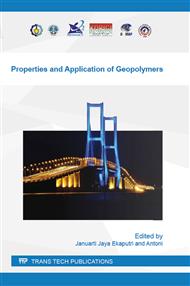[1]
Wang, Li and Yan (2005). Synthesis and mechanical properties of metakaolinite-based geopolymer. Colloids and Surfaces A: Physicochemical and Engineering Aspects, 268(1-3), 1-6.
DOI: 10.1016/j.colsurfa.2005.01.016
Google Scholar
[2]
Yip, Lukey and Van Deventer (2005). The coexistence of geopolymeric gel and calcium silicate hydrate at the early stage of alkaline activation. Cement and concrete research, 35(9), 1688-1697.
DOI: 10.1016/j.cemconres.2004.10.042
Google Scholar
[3]
Xu and Van Deventer (2002). Geopolymerization of multiple minerals. Mineral Engineering, 15, 1131.
Google Scholar
[4]
Zuhua, Xiao, Huajun and Yue (2009). Role of water in the synthesis of calcined kaolin based geopolymer. Applied Clay Science, 43, 218-223.
DOI: 10.1016/j.clay.2008.09.003
Google Scholar
[5]
Rovnanik (2010). Effect of curing temperature on the development of hard structure of metakaolin-based geopolymer. Construction and Building Materials, 24, 1176-1183.
DOI: 10.1016/j.conbuildmat.2009.12.023
Google Scholar
[6]
Zhang, Wei and Li (2009). Preparation and microstructure of K-PSDS geopolymeric binder. Colloids and Surfaces A: Physicochemical and Engineering Aspects, 302, 473-482.
DOI: 10.1016/j.colsurfa.2007.03.031
Google Scholar
[7]
Rattanasak and Chindaprasirt (2009). Influence of NaOH solution on the synthesis of fly ash geopolymer. Minerals Engineering, 22(12), 1073-1078.
DOI: 10.1016/j.mineng.2009.03.022
Google Scholar
[8]
Duxson, Lukey and Van Deventer (2007). Physical evolution of Na-geopolymer derived from metakaolin up to 1000°C. Journal of Materials Science, 42, 3044-3054.
DOI: 10.1007/s10853-006-0535-4
Google Scholar
[9]
Tempest, Sanusi, Gergely, Ogunro and Weggel (2009). Compressive strength and embodied energy optimization of fly ash based geopolymer concrete. Paper presented at the 2009 World of Coal Ash (WOCA).
DOI: 10.1061/41165(397)135
Google Scholar
[10]
Sami Ullah, Faiz Ahmad, A. M Shariff and M.A. Bustam (2014). Synergistic effects of kaolin clay on intumescent fire retardant coating composition for fire protection of structural steel substrate.
DOI: 10.1016/j.polymdegradstab.2014.08.017
Google Scholar
[11]
Fernandez-Jimenez and Palomo (2007). Factor affecting early compressive strength of alkali activated fly ash (OPC-free) concrete. Materials de Construction, 57, 7-22.
DOI: 10.3989/mc.2007.v57.i287.53
Google Scholar
[12]
Provis, Yong, Duxson and Van Deventer (2009). Correlating mechanical and thermal properties of sodium silicate-fly ash geopolymers. Colloids and surfaces A: Physicochemical and Engineering Aspects, 336(1-3), 57-63.
DOI: 10.1016/j.colsurfa.2008.11.019
Google Scholar
[13]
Xiao, Zuhua, Huajun and Yue (2009). Geopolymerization process of alkali-metakaolinite characterized by isothermal calometry. Thermochimica Acta, 493, 49-54.
DOI: 10.1016/j.tca.2009.04.002
Google Scholar
[14]
Lee and Van Deventer (2002). The effects of inorganic salt contamination on the strength and durability of geopolymers. Colloids and Surfaces, 211, 115-126.
DOI: 10.1016/s0927-7757(02)00239-x
Google Scholar
[15]
Chindaprasirt, Chareerat and Sirivivatnanon (2007). Workability and strength of coarse high calicium fly ash geopolymer. Cement and concrete composites, 29(3), 224-229.
DOI: 10.1016/j.cemconcomp.2006.11.002
Google Scholar
[16]
Hardjito and Rangan (2005). Development and properties of low-calcium fly ash based geopolymer concrete. Research report GCI. Faculty of Engineering Curtin University of Technology, Perth, Australia.
Google Scholar
[17]
Alonso and Palomo (2001). Alkaline activation of metakaolin and calcium hydroxide mixtures: Influence of temperature, activator concerntration and solids ratio, Materials Letters, 47(1-2), 55-62.
DOI: 10.1016/s0167-577x(00)00212-3
Google Scholar


